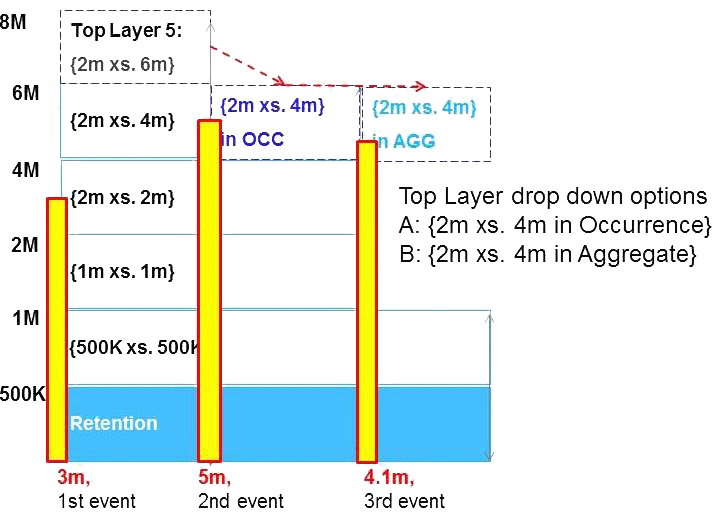As the soft market for insurance and reinsurance persists, providers are seeking ways to maintain their levels of coverage at a lower price. While competition amongst reinsurers remains fierce, there are deals to be had for insurers. As insurers are more frequently turning to complex contracts that offer a wide array of terms, the demand for flexibility, conditionality, and customization in reinsurance contract design is growing.
Designing contracts for optimization and reuse of coverage capacity in different loss frequency and magnitude scenarios is an increasingly attractive option, particularly in an environment in which the frequency and severity of significant loss causing events—such as severe thunderstorms and floods—are climbing as global temperatures and sea levels rise.
One flexible reinsurance multi-layered structure, which allows optimal reuse of reinsurance coverage, is the Top and Drop contract. These are not a new proposition, for they have been available on the Lloyds' P&C market since the late 1980's as a means of providing extended coverage over multiple events.
In a Top and Drop contract, the reinsurer provides a clause to reuse the top excess-of-loss layer in the reinsurance tower if the retention of this top layer is not breached by the first loss event. Following an event, if this layer remains intact, it acts as a reinstatement on one or more of the lower layers (the "Drop"). This creates two possible outcomes for the duration of the contract (Figure 1).

The first event in Figure 1—a USD 7 million loss event—breaches the retention of the top layer, such that reinsured claims in this layer between USD 6 million and USD 8 million are settled and reinsurance coverage for second, third, and further loss events is not available.
In an alternative scenario, a first loss event does not breach the retention of the top layer, triggering the "Drop" mechanism and moving the unused top layer down on top of a multi-tiered, second event tower now available for subsequent events. Figure 2 provides such a scenario, in which the first loss event of USD 3 million does not breach the top layer, which is dropped to cover the second loss event of USD 5 million.

Traditional programs focus on severity protection by providing Top-Up occurrence layers with one or two reinstatements. Based on historical claims experience and model results, both cedants and reinsurers see a need for more frequency protection. Furthermore, additional depth for smaller and staggered claims toward the term end of the contract is also needed. When not exhausted by prior high and medium severity events, the protection of the top layer in a Top and Drop contract continues to be available with a follow-up aggregate option for the drop-down layer. With this option, the unused top layer extends aggregate coverage for the duration of the reinsurance contract. In our second example, this is reflected in a USD 2 million excess of USD 2 million term aggregate limit, which covers claims accumulation to the end of the contract and embraces a third loss event of USD 4.1 million.
For some insurers, a purely occurrence-based, fully stacked reinsurance tower with unlimited top layer reinstatements for the duration of the contract can prove expensive, and optimization is a concern as coverage capacity will remain unused periodically. Top and Drop coverage provides some clear and immediate advantages. In particular, it enables an insurer to buy top layers of coverage for a first loss event for a competitive premium knowing that if the top layer capacity remains unused, it will automatically drop down to cover further events. With both insurers and reinsurers looking for optimized solutions, more choices, and reusability of coverage capacity, we will likely be seeing more conditional and reusable structures.
